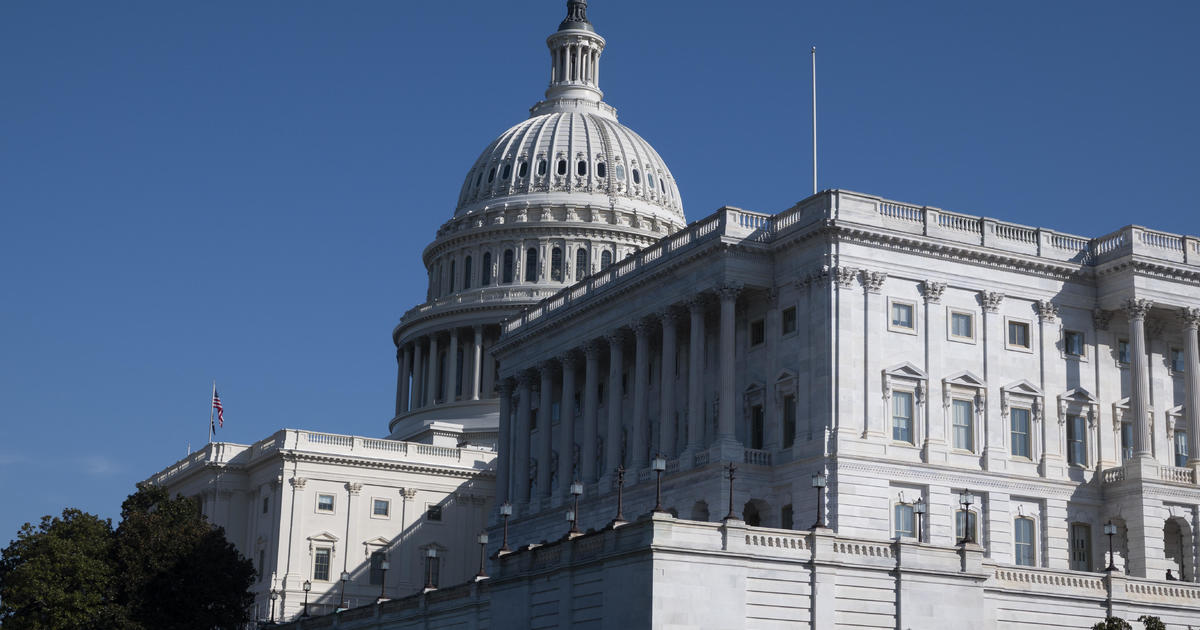Supreme Court seems skeptical of finding that South Carolina congressional district was racial gerrymander
Washington — The Supreme Court's conservative majority expressed skepticism Wednesday with a lower court's finding that a congressional district in South Carolina was racially gerrymandered in violation of the Constitution as it weighed a case that tested the disentangling of racial and political motivations for drawing voting lines.
The justices spent much of the two-hour argument session questioning the validity of testimony by experts who appeared before a three-judge district court panel in October 2022. The justices debated why, after the Supreme Court effectively said partisan gerrymandering is permissible, mapmakers would have to impermissibly rely on race even if its used as a proxy for politics.
"You think looking at 2020 and figuring out 'were you a Trump voter or were you a Biden voter' is not probative to whether you're going to vote for Nancy Mace or not in the last election?" Justice Brett Kavanaugh asked Caroline Flynn, an attorney in the solicitor general's office who argued on behalf of the Biden administration.
Republicans in South Carolina, who drew the new voting lines after the 2020 Census, said data from the 2020 presidential election provided a political explanation for the design of Congressional District 1, which the lower court said was an unconstitutional racial gerrymander. The lawmakers have said politics was the predominant motivating factor during the redistricting process, not race.
"Suppose we think that data is fairly probative, does the whole case that plaintiffs had, the district court's conclusion, then all fall? Because that's really the linchpin of the response to the main argument that the state's giving, which is we relied on this political data," Kavanaugh said. "If that data is good, should we reverse?"
The justices are reviewing a decision from the three-judge panel in South Carolina that found state Republican lawmakers intentionally let race drive the design of Congressional District 1.
The dispute is the latest to come before the high court arising from the redistricting process that took place after the 2020 Census. But unlike a closely watched dispute involving Alabama's congressional map, which the high court found likely violated the Voting Rights Act, the court battle involving the single district in South Carolina centers around claims that race was improperly used during the map-drawing process in violation of the Constitution's Equal Protection Clause.
Chief Justice John Roberts pressed Flynn and Leah Aden, who argued on behalf of the NAACP of South Carolina, about the strength of the evidence offered by the map's challengers during lower court proceedings. He expressed concern about the consequences of a ruling upholding the district court's decision.
"We've never had a case where there's been no direct evidence, no map, no strangely configured districts, a very large amount of political evidence, whether the district court chose to credit it or not, and instead it's all resting on circumstantial evidence," he told Aden, adding, "I'm not saying you can't get there, but it does seem that this would be breaking new ground in our voting rights jurisprudence."
Roberts later asked Flynn whether the Justice Department had ever supported a plaintiff in a case similar to the one before the court.
"My point is a clear one," he said. "Have you ever seen anything like this?"
The dispute over Congressional District 1
Located along the state's southeastern coast and anchored in Charleston County, the voters of Congressional District 1 have elected Republicans to the House from 1980 to 2016. But in 2018, Democrat Joe Cunningham won the seat in what was widely considered to be an upset win. The following congressional election, in 2020, saw a narrow victory by Republican Nancy Mace.
During the redistricting process that began in 2021 when state lawmakers redrew South Carolina's congressional voting map, GOP officials sought to give Congressional District 1 a stronger Republican tilt. To do this, they moved more than 140,000 residents out of District 1 and into Congressional District 6, long represented by Democratic Rep. Jim Clyburn.
The map was enacted in January 2022, and Mace won reelection that November. But the NAACP's South Carolina chapter and voter Taiwan Scott challenged the lines of Congressional District 1 as an unconstitutional racial gerrymander, and alleged the district was designed with racially discriminatory intent. Following an eight-day trial, the three-judge district court panel agreed with the map's challengers and found that race was the predominant factor in the drawing of the district.
The panel concluded that GOP lawmakers set a target of 17% Black voting-age population in Congressional District 1 and moved more than 30,000 Black residents from their home district into Congressional District 6 to produce a Republican tilt. The district court blocked the state from conducting an election with the GOP-drawn bounds for Congressional District 1, though it gave the legislature until 30 days after the Supreme Court issues a final decision to submit new lines.
South Carolina Republicans asked the Supreme Court in February to review the district court's decision, arguing it failed to adhere to the presumption that the Legislature acted in good faith, and did not disentangle race from politics.
"Mere awareness of race does not prove racial dominance," John Gore, who argued on behalf of the state, told the justices.
Gore argued that the GOP legislators drew Congressional District 1 to adhere to traditional districting principles and sought to create a more secure Republican district. The Supreme Court in 2019 said the doors of federal courts were closed to claims of partisan gerrymandering, the practice of drawing voting lines to entrench the party in power.
"The General Assembly had no reason to and did not use a racial target," he said. "It used political data to pursue its political goals."
But civil rights groups, which are encouraging the Supreme Court to let the panel's decision stand, argued that using race as the predominant factor for sorting voters violates the Constitution, even if it's done for partisan gain, and said state lawmakers failed to prove "clear error" with the district court judges' factual findings.
"Black people were treated one-to-one, traded one in, one out," Aden said, referencing the 30,000 Black voters who were moved out of Congressional District 1. "It's only Black people in the design of this district that were treated with racial stereotyping, which is offensive to the Constitution."
Several of the justices focused on the district court's finding that GOP lawmakers set a target of 17% Black voting-age population in order to make Congressional District 1 more Republican-leaning.
Justice Ketanji Brown Jackson noted that the 17% figure remained unchanged even as maps proposed by state mapmakers evolved and the design of Congressional District 1 changed.
"Thousands of people were moved in and out of this district and yet that line, the line concerning the amount of Black adult-voter participation, remained the same," she said. "If what the court found here was not happening, how do you explain the consistency of that line?"
But Justice Samuel Alito later indicated that was to be expected if Republican lawmakers, in a state where race and party align, were driven by a political objective.
"If they are disregarding race entirely and looking only at politics, where race and politics are so closely aligned, it isn't surprising that when you want to get a district that has a certain Republican percentage, you're going to get a district that has a steady [Black voting age population]," he said.
Justice Neil Gorsuch noted that legislatures can use party to achieve political goals under the Supreme Court's prior decisions, and suggested the absence of an alternative map hurt the civil rights group's case.
"The plaintiff bears the burden of overcoming a good-faith presumption that the legislature is doing just what it says," he said. "How do you prove that they are acting in bad faith without showing that they could achieve their objective some different way?"
The means for sorting voters, whether by race or politics, was expected to be a key factor during arguments, especially when it comes to states where voting is polarized, making it difficult to separate race from politics.
"At its core, this case is a race or politics case because the court erroneously thinks partisan gerrymandering isn't the problem for it to police, partisanship ends up being a successful defense to claims of racial gerrymandering. The question is which motive dominated, is it race or partisanship?" Nicholas Stephanopoulos, a law professor at Harvard University, told CBS News.
Justin Levitt, a law professor at Loyola Marymount University, likened the improper focus on race during redistricting to a driver who only watches the speedometer and ignores traffic patterns, road conditions and other vehicles.
"If you're so fixated on the speedometer that you ignore everyone else and only stare at the speedometer, you're going to crash," he told CBS News. "The allegation proven to a trial court is essentially, South Carolina was only looking at the speedometer and crashed."
Levitt said he believes it's unlikely the Supreme Court will make it more difficult for voters to challenge the use of race as a driving factor in the crafting of district lines, but said the case is important because "when legislature have a single-minded focus, as was proven here, they do damage to the public interest."
"The overall thrust is the court's suspicion that state governments should be doing things based on race," he said. "It's not that they say districts have to be drawn race-blind, but the thrust of their opinions elsewhere is real skepticism of race driving the train. I don't think they'll back off of this type of claim. The risk is that as a practical matter, it's difficult for plaintiffs to prove that a state legislature was in fact drawing districts in order to put minority constituents inside or outside of their district without good reason."



